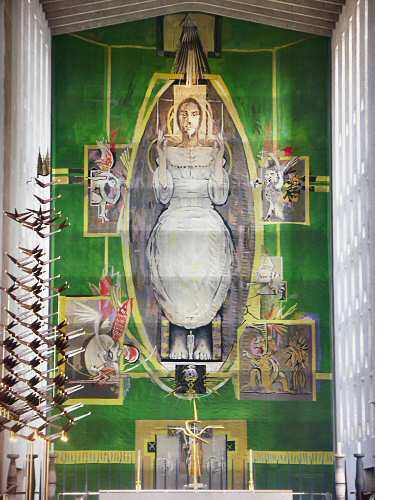Thanks for visiting Art History Abroad’s blog, we hope you enjoy it. We run brilliant Summer and Gap Year courses for students aged 16+. Follow our courses on Instagram or read our ⭐️⭐️⭐️⭐️⭐️ reviews on the GoOverseas review site, or watch our video.
The cathedral of Coventry is famous for its celebration of building something new out of something old that had been dramatically destroyed. Like Achilles arising from his funeral pyre, or the mythical Phoenix, Coventry Cathedral was re-born. Since the trauma that the city underwent, there grew a desire for the new Cathedral to be created in an entirely modern and revivalist manner, in both its architectural design, and for the art works inside.
This task fell to Sir Basil Spence, and he ultimately designed the ‘jewel box’ Cathedral. Within the new, innovative building, is the vast tapestry designed by Graham Sutherland, and it certainly captures your attention. Christ looks out from an emerald background, surrounded by stylized versions of the four evangelists. What makes this image of Christ instantly recognizable is Sutherland’s decision to draw on the traditional iconography of us as a society associate with Christ. Over thousands of years, Christ has maintained the same basic facial physiology such as the oval face, long nose and signature parted hair and small, clean cut beard. Combined with his piercing gaze and the presence of the halo, the majority of society would be familiar with this stereotypical view of Christ.
The importance of Christ Jesus as an icon is not something to be ignored. For Sutherland, his image of Christ had to be instantly distinguishable, due to the size and position of the work. Christ’s representation strives to somehow embody and invoke his presence within the Cathedral and this reflects an important ideal in Christian teaching with regards to the Eucharist and receiving Communion. The tapestry serves to direct the mind of the congregation to a further reverence and appreciation of spiritual matters. Christ’s very insistent and assertive stare is one we certainly cannot escape from, a reminder perhaps to the congregation that Christ sees into every part of us . As humans, we are drawn to eyes and so the use of the full frontal gaze is very effective.
The tapestry produces a sense of awe and overwhelms the viewer with the grandeur and majesty of Christ. As we look deeper into the tapestry,we gain a sense of Christ’s humanity, which is further emphasised by the wounds he shows us. The ambiguous halo that surrounds his head, coupled with the life-sized figure of a man at his feet serves to remind us of our own mortality. All this considered, the image’s glory is undeniable. The success of Sutherland’s tapestry comes from its ability to invoke familiar religious imagery and yet be modern and innovative in its approach. A highly suitable piece for a rebuilt Christian Cathedral, a structure which by its very nature is a metaphor for the Christian expectation of resurrection.




